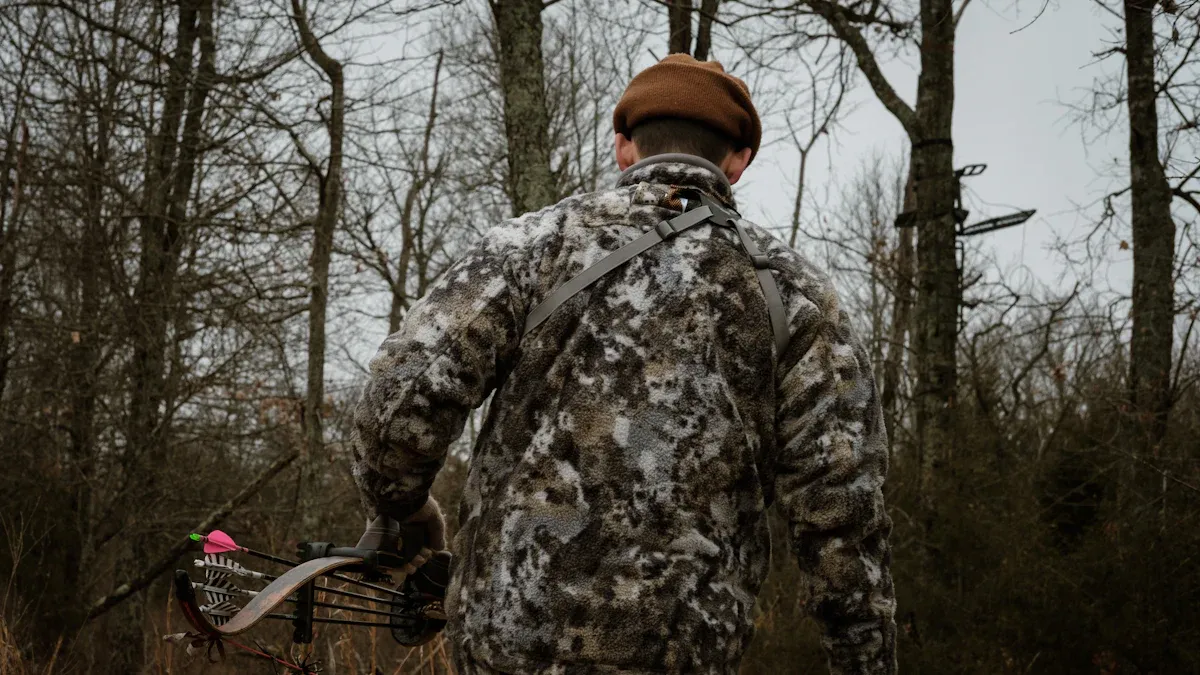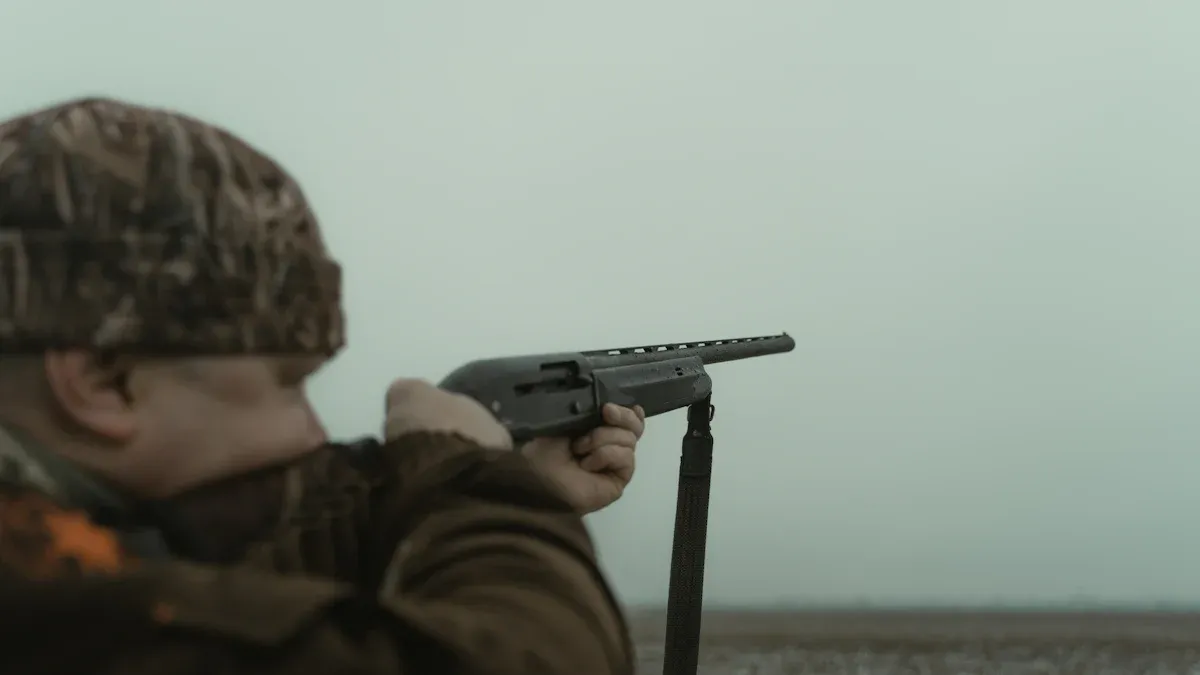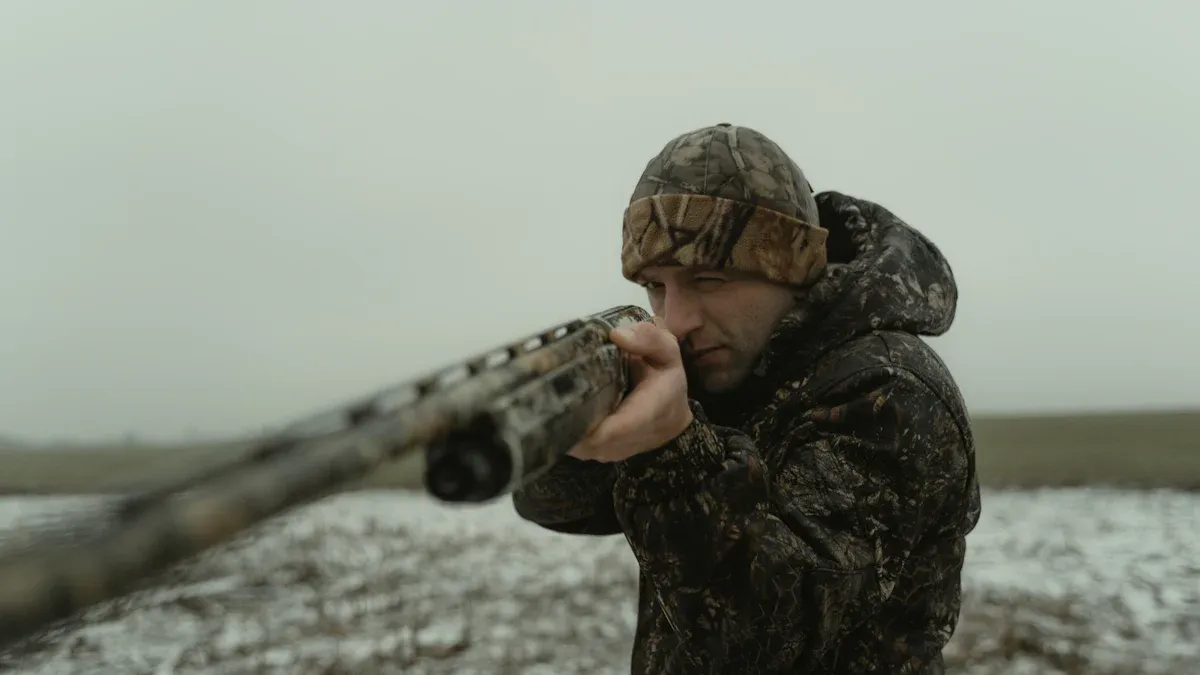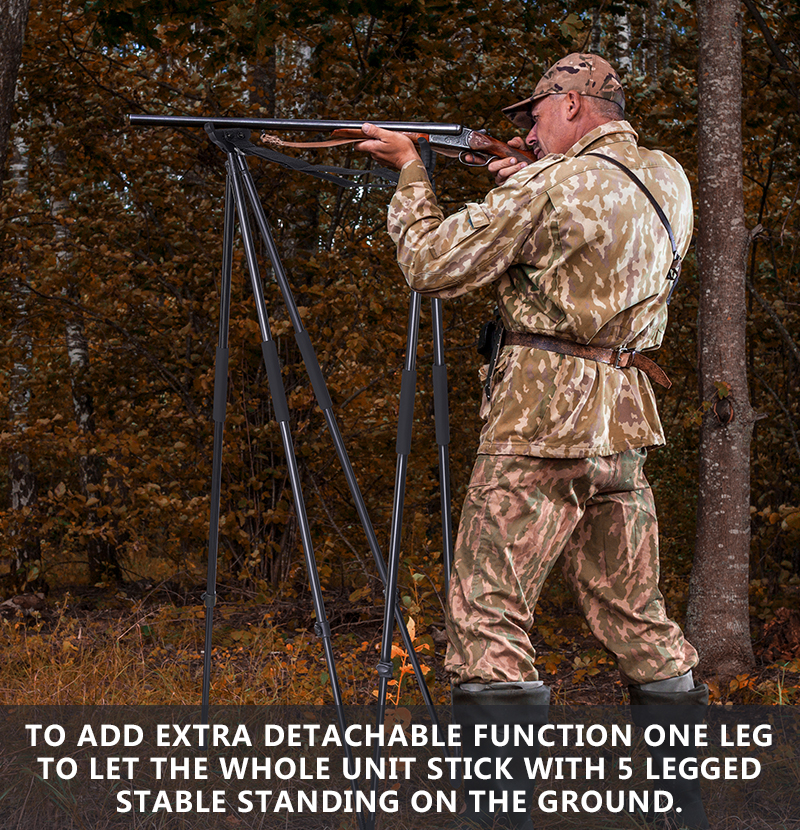
Selecting the right 4 Legged Hunting Stick requires attention to stability, adjustability, and weight. Hunters should prioritize comfort and match the stick’s features to their preferred terrain and hunting style. > A stable platform supports accurate shots, while adjustability accommodates various shooting positions. Durability ensures long-term reliability in the field. Hunters benefit most when they choose equipment that performs well with their typical game and environment.
Key Takeaways
- Choose a 4 legged hunting stick that offers strong stability and side-to-side support to improve shooting accuracy on all terrains.
- Look for adjustable height and quick-adjust mechanisms to easily switch between standing, kneeling, and sitting positions during your hunt.
- Pick a lightweight and portable stick made from durable materials like carbon fiber or aluminum to reduce fatigue and ease transport.
- Test the stick’s comfort, grip, and silent operation before buying to ensure it feels natural and won’t scare game away.
- Match your hunting stick features to your hunting style and terrain for better performance and a more successful hunt.
4 Legged Hunting Stick: What It Is and Why It Matters

Definition and Core Benefits
A 4 Legged Hunting Stick serves as a shooting support tool designed for hunters who demand maximum stability in the field. This equipment features four legs that create a wide, sturdy base. Hunters use it to steady their aim, especially during long waits or when targeting game at a distance. The design allows for hands-free operation, which means a hunter can rest their firearm securely while scanning the environment or preparing for a shot.
Key benefits include:
- Enhanced stability for precise shooting
- Support for a variety of shooting positions, such as standing, kneeling, or sitting
- Reduced fatigue during extended hunts
- Improved accuracy, especially in challenging conditions
Note: Many hunters find that a 4 Legged Hunting Stick helps them maintain focus and reduces muscle strain, which can make a significant difference during long hours in the field.
Advantages Over Bipods and Tripods
A 4 Legged Hunting Stick offers several advantages compared to bipods and tripods. Bipods provide basic support but often lack side-to-side stability. Tripods improve on this but may still wobble on uneven ground. The four-legged design delivers superior balance, even on rough or sloped terrain.
| Feature | Bipod | Tripod | 4 Legged Hunting Stick |
|---|---|---|---|
| Stability | Moderate | Good | Excellent |
| Versatility | Limited | Moderate | High |
| Terrain Adaptability | Low | Moderate | High |
Hunters who pursue game in unpredictable environments often choose a 4 Legged Hunting Stick for its unmatched support. The extra leg provides a broader footprint, which helps prevent tipping and allows for smoother tracking of moving targets.
Key Features to Look for in a 4 Legged Hunting Stick
Stability and Side-to-Side Support
Stability stands as the most critical feature in any shooting support. A 4 Legged Hunting Stick provides a wide base, which helps shooters maintain a steady aim. The four legs distribute weight evenly, reducing the risk of tipping or wobbling. This design allows hunters to track moving targets with greater confidence.
Many models offer reinforced joints and non-slip feet. These features prevent unwanted movement, even on uneven or slippery ground. Hunters who pursue game in windy or unpredictable conditions benefit from the extra side-to-side support. A stable shooting platform leads to more accurate shots and fewer missed opportunities.
Tip: Test the stick’s stability by applying gentle pressure from different angles. A quality model should resist shifting or collapsing.
Height Adjustability and Shooting Positions
Height adjustability allows hunters to adapt quickly to changing situations. Most 4 Legged Hunting Sticks feature telescoping legs or locking mechanisms. These adjustments help shooters switch between standing, kneeling, or sitting positions with ease.
A good stick should offer a wide range of height settings. This flexibility supports hunters of different sizes and shooting styles. Some sticks include quick-release levers for fast changes in the field. Others use twist locks for secure adjustments.
| Shooting Position | Minimum Height Needed | Maximum Height Needed |
|---|---|---|
| Sitting | 20-30 inches | 35-40 inches |
| Kneeling | 30-40 inches | 45-50 inches |
| Standing | 45-55 inches | 60-70 inches |
Hunters who hunt from blinds or thick cover often need to adjust their shooting height quickly. A stick with smooth, reliable adjustment features saves time and reduces noise.
Weight and Portability
Weight plays a major role in a hunter’s comfort and mobility. A lightweight 4 Legged Hunting Stick makes long hikes and spot-and-stalk hunts less tiring. Most modern sticks use materials like aluminum or carbon fiber. These materials offer strength without adding unnecessary bulk.
Portability also matters. Some sticks fold down to a compact size for easy transport. Others include carrying straps or clips that attach to a backpack. Hunters should consider how far they plan to walk and how much gear they already carry.
Note: A stick that feels light in the store may seem heavier after several hours in the field. Always factor in the total weight of your gear.
A well-chosen stick balances weight and durability. It should feel sturdy but not cumbersome. Portability features help hunters move quietly and efficiently through different types of terrain.
Durability, Materials, and Quietness
Durability stands as a top priority for any hunter investing in new gear. A 4 Legged Hunting Stick must withstand harsh weather, rough handling, and repeated use. Manufacturers often use materials like aircraft-grade aluminum, carbon fiber, or reinforced polymers. These materials resist corrosion and damage while keeping the stick lightweight.
Hunters should check for:
- Reinforced joints and hinges
- Rust-resistant coatings
- High-quality locking mechanisms
Quietness also plays a crucial role in hunting success. Noisy gear can spook game before a shot. Many premium sticks feature rubberized feet and padded contact points. These additions help dampen sound when setting up or adjusting the stick.
Pro Tip: Test the stick in-store by opening and closing the legs. Listen for clicks or squeaks. Silent operation gives hunters a real advantage in the field.
Head Attachments and Range of Movement
The head attachment determines how smoothly a hunter can track moving targets. Some 4 Legged Hunting Sticks use a simple V-yoke, while others offer swiveling or tilting heads. A quality head attachment allows for fluid movement without sacrificing stability.
Common head types include:
- Fixed V-yoke: Simple and reliable, best for stationary shots
- Swivel head: Rotates for tracking game across a wide arc
- Ball head: Offers tilt and pan for maximum flexibility
| Head Type | Movement Range | Best Use Case |
|---|---|---|
| Fixed V-yoke | Limited | Still targets |
| Swivel Head | 360° | Moving game |
| Ball Head | Multi-axis | Uneven terrain, fast shots |
A smooth head attachment helps hunters stay on target as animals move. It also reduces the need to reposition the entire stick, saving time and effort.
Grip Comfort and Ease of Use
Grip comfort affects how long a hunter can use the stick without fatigue. Many models feature foam or rubberized grips. These materials cushion the hands and provide a secure hold, even in wet or cold conditions.
Ease of use matters in high-pressure moments. Hunters should look for:
- Ergonomic grip shapes
- Intuitive locking levers
- Clearly marked adjustment points
Note: A comfortable grip and simple controls allow hunters to focus on the shot, not the equipment.
A well-designed 4 Legged Hunting Stick feels like an extension of the hunter’s body. It should set up quickly, adjust smoothly, and remain comfortable during long waits.
Quick-Adjust Mechanisms
Quick-adjust mechanisms set apart high-quality hunting sticks from basic models. These features allow hunters to change the height or configuration of their shooting support in seconds. Fast adjustments can make the difference between a missed opportunity and a successful shot, especially when game appears suddenly or changes position.
Hunters encounter several types of quick-adjust systems:
- Lever Locks: These mechanisms use a simple flip lever to secure or release each leg. Lever locks work well in cold weather because hunters can operate them with gloves. They provide a strong hold and allow for rapid changes.
- Twist Locks: This system requires a simple twist of the leg section to loosen or tighten. Twist locks offer a sleek design and reduce snagging on brush. Some hunters prefer them for their reliability, though they may take slightly longer to adjust than lever locks.
- Push-Button Systems: Push-button mechanisms use spring-loaded buttons that snap into preset holes along the leg. This design allows for quick, repeatable adjustments. Hunters can feel and hear the button engage, which adds confidence in the field.
- Integrated Slide Systems: Some premium sticks feature a slide-and-lock system. Hunters slide the leg to the desired height and it locks automatically. This method offers the fastest adjustment and works well for spot-and-stalk hunting.
Tip: Hunters should test each mechanism before purchase. A smooth, silent adjustment can prevent spooking game and save valuable seconds.
Quick-adjust mechanisms benefit hunters in several ways:
- Speed: Hunters can adapt to changing terrain or shooting positions without fumbling.
- Stealth: Quiet adjustments help maintain concealment.
- Safety: Secure locks prevent accidental collapse, protecting both the hunter and the firearm.
- Versatility: Hunters can switch from standing to kneeling or sitting positions with minimal effort.
The best quick-adjust systems combine speed, strength, and silence. Hunters should look for mechanisms that operate smoothly and lock securely. They should also consider how the system performs in wet, muddy, or freezing conditions. A reliable quick-adjust feature ensures the hunting stick remains an asset, not a liability, during critical moments.
Matching Your 4 Legged Hunting Stick to Your Hunting Style
Big Game Hunting
Hunters who pursue big game, such as deer or elk, often face long waits and challenging shots. They need a shooting support that delivers maximum stability and adapts to different shooting positions. A stick with a wide base and reinforced joints helps maintain accuracy during high-pressure moments. Many hunters prefer models with quick-adjust mechanisms, which allow fast changes from sitting to standing. In dense cover or from a blind, a stick with silent adjustments prevents spooking wary animals. Hunters should also consider the weight of their gear, as big game hunts may involve long hikes across rugged terrain. A lightweight, durable stick reduces fatigue and supports steady aim during critical shots.
Predator and Varmint Hunting
Predator and varmint hunters often move quickly and set up in a variety of locations. They need a support that offers both portability and rapid deployment. Many users report that four-legged sticks, such as the 4 Stable Sticks, provide superior stability and quicker setup compared to bipods or tripods. These sticks perform well in uneven or rolling terrain, where other supports may struggle. Hunters appreciate the ability to shoot comfortably from a sitting position, especially when using a sportsman’s chair to avoid ground hazards. Adjustable height and a stable platform make these sticks effective for longer-range shots, such as targeting prairie dogs at 200 yards. While bipods remain popular for their quality, they can be less versatile in tall grass or on rough ground.
Tip: Choose a stick that adjusts quietly and locks securely, especially when hunting wary predators that react to sudden sounds.
Turkey and Small Game
Turkey and small game hunters often need to move quietly and set up quickly. A compact, lightweight stick helps them stay mobile and react to fast-moving targets. Many prefer models with foam grips and silent adjustment features, which allow for stealthy repositioning. The ability to shoot from low positions, such as sitting or kneeling, proves valuable in thick cover or when hunting from a ground blind. A stick with non-slip feet and a comfortable grip supports accurate shots without adding bulk to the hunter’s kit. For small game, quick-adjust mechanisms and a stable base help maintain accuracy during rapid follow-up shots.
Spot-and-Stalk vs. Stand Hunting
Hunters often choose between spot-and-stalk and stand hunting methods. Each approach demands different features from shooting supports. Spot-and-stalk hunting requires mobility and quick adaptation. Hunters move through the landscape, scanning for game and closing the distance before taking a shot. They need equipment that sets up fast and packs down small.
A lightweight stick with a compact folding design works best for spot-and-stalk. Hunters benefit from quick-adjust mechanisms that allow rapid changes in height. Silent operation becomes crucial, as game animals react to unexpected sounds. Many hunters prefer models with padded grips and rubberized feet for quiet movement. Portability also matters. A stick that attaches easily to a backpack or belt frees up the hunter’s hands during travel.
Stand hunting involves waiting in a fixed position, often in a tree stand or ground blind. Hunters may spend hours in one spot, watching for game to approach. Stability and comfort become top priorities. A heavier, more robust stick provides a solid shooting platform for long periods. Adjustable legs help hunters set the stick at the perfect height for their seat or blind window.
Tip: Hunters should test their shooting stick in both standing and seated positions before the season starts. This practice ensures smooth transitions and builds confidence in the field.
The table below highlights the key differences:
| Hunting Style | Key Needs | Recommended Features |
|---|---|---|
| Spot-and-Stalk | Mobility, speed, stealth | Lightweight, quick-adjust, compact, silent operation |
| Stand Hunting | Stability, comfort | Heavy-duty, adjustable, stable, padded grips |
Hunters who match their shooting support to their hunting style gain an advantage. The right choice improves accuracy and comfort, leading to more successful hunts.
4 Legged Hunting Stick Performance in Different Terrains

Open Fields and Plains
Hunters in open fields and plains often face steady winds and long shooting distances. Stability becomes a top priority. The wide base of a four-legged stick helps shooters maintain a steady aim, even when gusts pick up. Many hunters choose models with adjustable legs to handle uneven patches of ground. Lightweight materials, such as carbon fiber, allow for easy transport across large fields. Hunters can set up quickly and track game that moves across open spaces.
Tip: In open terrain, hunters should look for sticks with non-slip feet. These features prevent sliding on dry grass or hard-packed soil.
Wooded Areas and Forests
Dense woods present unique challenges. Hunters must move quietly and set up in tight spaces. A compact, foldable stick works best in these environments. Shorter leg adjustments help shooters stay low and hidden behind brush or fallen logs. Foam grips and silent locking mechanisms reduce noise, which helps avoid alerting game. Hunters often need to shoot from kneeling or sitting positions. A stick that adjusts smoothly supports these needs.
- Key features for wooded areas:
- Quiet operation
- Compact folding design
- Quick height adjustments
Mountainous and Uneven Ground
Mountain terrain demands equipment that adapts to steep slopes and rocky surfaces. Hunters often climb or traverse uneven ground. A sturdy stick with reinforced joints provides extra support on inclines. Adjustable legs allow each foot to rest at a different height, keeping the shooting platform level. Rubberized feet grip rocks and prevent slipping. Portability remains important, as hunters may hike long distances at high elevations.
| Terrain Feature | Recommended Stick Attribute |
|---|---|
| Steep slopes | Independently adjustable legs |
| Rocky ground | Rubberized, non-slip feet |
| Long hikes | Lightweight construction |
Note: Hunters should test their stick on uneven ground before heading into the mountains. Reliable performance in tough terrain can make the difference between a missed shot and a successful hunt.
Wetlands and Marshes
Wetlands and marshes challenge hunters with soft, unstable ground and frequent water hazards. Hunters often face slippery mud, standing water, and thick vegetation. Equipment must perform reliably in these demanding conditions. A shooting stick with wide, rubberized feet prevents sinking and slipping. This feature keeps the support steady on muddy banks or floating mats of vegetation.
Many hunters choose models with corrosion-resistant materials. Aluminum and carbon fiber resist rust and damage from constant moisture. Joints and locking mechanisms should operate smoothly even after exposure to water and grit. Hunters benefit from sticks with sealed or covered components. These designs block mud and debris from entering moving parts.
Portability remains important in wetlands. Hunters may need to wade through water or cross floating vegetation. Lightweight construction allows for easy transport. Some sticks include carrying straps or clips for hands-free movement. Quick-deploy features help hunters set up rapidly when game appears.
Tip: Hunters should rinse their shooting stick after each trip into marshy areas. This practice removes mud and prevents buildup in joints.
Noise discipline becomes critical in wetlands. Waterfowl and marsh game react quickly to unnatural sounds. Foam grips and padded contact points reduce noise during setup and adjustment. Hunters should test their equipment for silent operation before entering the field.
A table below summarizes key features for wetlands and marshes:
| Feature | Benefit |
|---|---|
| Wide, rubberized feet | Prevents sinking and slipping |
| Corrosion-resistant | Withstands constant moisture |
| Lightweight design | Eases transport through water |
| Silent adjustments | Avoids spooking game |
Hunters who prepare for wetland conditions gain a clear advantage. The right shooting stick supports accurate shots and reliable performance in even the most challenging environments.
Practical Tips for Choosing the Right 4 Legged Hunting Stick
Test In-Store for Fit and Comfort
Hunters gain valuable insight by handling equipment before making a purchase. Testing a hunting stick in-store allows users to check the weight, grip, and adjustment mechanisms. They can extend the legs, try different shooting positions, and feel the balance. Many stores provide sample models for this purpose. A stick that feels comfortable in the hands and adjusts smoothly will likely perform well in the field. Hunters should wear gloves during testing to simulate real hunting conditions.
Tip: Move through standing, kneeling, and sitting positions while holding the stick. This process helps identify any awkward angles or uncomfortable grips.
Read User Reviews and Expert Opinions
Online reviews and expert recommendations offer a wealth of information. Hunters can learn about real-world performance, durability, and potential issues. User feedback often highlights strengths and weaknesses that may not appear in product descriptions. Expert reviews provide technical analysis and compare different models. Reliable sources include hunting forums, outdoor magazines, and trusted gear websites.
- Look for patterns in feedback.
- Pay attention to comments about stability, noise, and ease of adjustment.
- Consider both positive and negative experiences.
A table of pros and cons from multiple reviews can help narrow down choices:
| Feature | Pros | Cons |
|---|---|---|
| Stability | Solid base, no wobble | May add weight |
| Adjustability | Quick, smooth transitions | Some locks can loosen |
| Portability | Easy to carry, folds small | May sacrifice strength |
Set a Realistic Budget
Setting a budget helps hunters focus on options that meet their needs without overspending. Prices for hunting sticks vary widely based on materials, features, and brand reputation. Entry-level models offer basic support, while premium sticks provide advanced adjustments and lightweight construction. Hunters should decide which features matter most and allocate funds accordingly.
Note: Investing in a quality stick often pays off in reliability and long-term use.
A clear budget prevents impulse buys and ensures satisfaction with the final choice.
Consider Brand Reputation and Warranty
Hunters often rely on their gear in demanding conditions. Brand reputation can signal quality and reliability. Well-known manufacturers usually invest in better materials and more rigorous testing. They also tend to offer stronger customer support. When choosing a hunting stick, buyers should research brands with a history of positive feedback from experienced hunters.
A warranty adds another layer of confidence. Leading brands often back their products with warranties that cover defects or failures. A good warranty shows that a company stands behind its craftsmanship. Hunters should check the length and terms of the warranty before making a purchase. Some brands offer limited lifetime coverage, while others provide only a year or two.
Tip: Save receipts and register products online when possible. This step can make warranty claims faster and easier.
A quick comparison table can help:
| Brand Reputation | Warranty Coverage | Customer Support |
|---|---|---|
| High | Lifetime | Responsive |
| Moderate | 1-2 Years | Average |
| Low | None | Limited |
Choosing a reputable brand with a solid warranty can reduce the risk of equipment failure during a hunt.
Think About Long-Term Use and Versatility
Hunters should consider how their shooting stick will perform over several seasons. A durable stick can handle rough terrain, harsh weather, and frequent travel. Versatility also matters. Some models adjust for different shooting positions or fold down for easy transport. Others accept accessories like camera mounts or spotting scopes.
A versatile stick adapts to various hunting styles and environments. For example, a hunter may use the same support for big game in the fall and small game in the spring. Adjustable features and modular designs increase the stick’s usefulness.
- Look for:
- Adjustable height and leg angles
- Compatibility with different firearms
- Easy maintenance and cleaning
Note: Investing in a versatile, long-lasting stick can save money and improve hunting success over time.
Hunters who plan for long-term use often enjoy better value and fewer equipment issues.
Selecting the right 4 Legged Hunting Stick requires careful attention to stability, adjustability, and durability. Hunters who test different models and research features often find equipment that improves accuracy and comfort. Each hunting environment presents unique challenges. A stick that matches personal needs will support better results in the field. Smart investment in quality gear leads to a more successful and enjoyable hunting experience.
FAQ
What makes a 4 legged hunting stick better than a tripod for hunting?
A 4 legged hunting stick provides greater stability and side-to-side support. Hunters experience less wobble, especially on uneven ground. This design helps maintain accuracy during long shots and in windy conditions.
Can a 4 legged hunting stick support heavy rifles?
Most quality 4 legged hunting sticks handle the weight of heavy rifles. Manufacturers use strong materials like carbon fiber or aluminum. Hunters should always check the stick’s weight rating before use.
How do you maintain a 4 legged hunting stick for long-term use?
Hunters should clean the stick after each trip, especially if exposed to mud or water. Lubricate moving parts and check for loose screws. Store the stick in a dry place to prevent corrosion.
Are 4 legged hunting sticks suitable for all types of terrain?
Yes, 4 legged hunting sticks adapt well to most terrains. Adjustable legs and non-slip feet help maintain stability on rocky, muddy, or uneven ground. Hunters find them reliable in forests, fields, mountains, and wetlands.
Post time: Jun-20-2025

